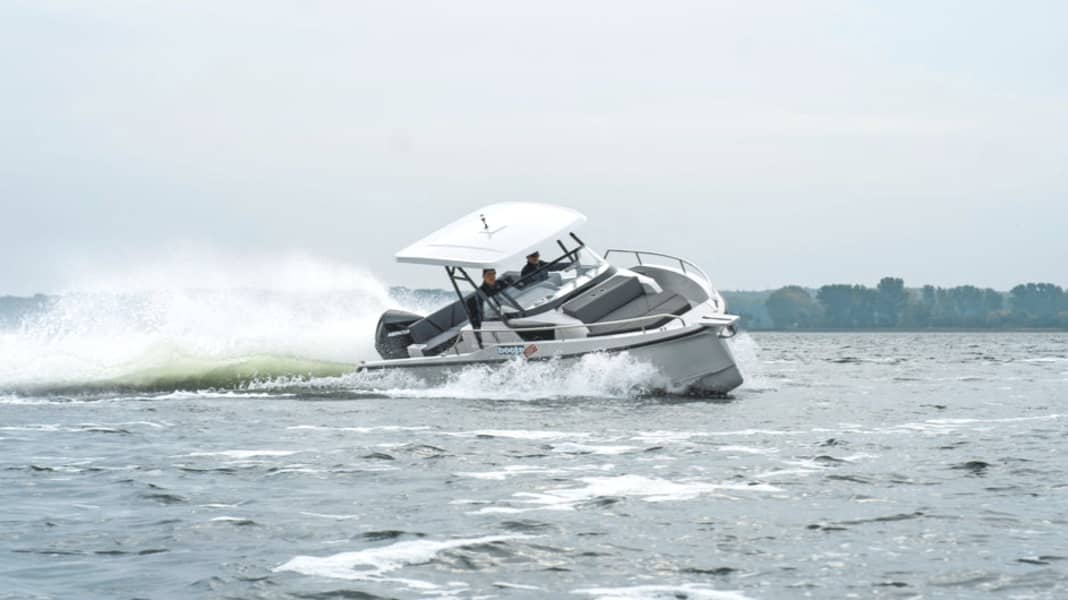
When the Greifswald Hansewerft shipyard took over the traditional Fjord brand in the early 2000s and gave its boats a new image, the experts were astonished. Who needs a boat like this? Large, around 40 knots fast, limited living space, with a straight stem and open stern. Just a fun boat for high earners?
The critics fell silent as sales figures rose steadily and Fjord became the trendsetter for a new type of boat. Other shipyards followed suit. Pardo, Nimbus, Saxdor and, above all, Axopar adopted the basic concept and developed it further. Downsizing was the watchword. Why not transfer the successful Fjord idea to smaller outboard-powered boats? In the years that followed, there was a real boom in this type of boat.
Today, around 15 years later, Hanse is following suit and is launching the Ryck 280, a boat that serves precisely this segment again, only smaller and cheaper.
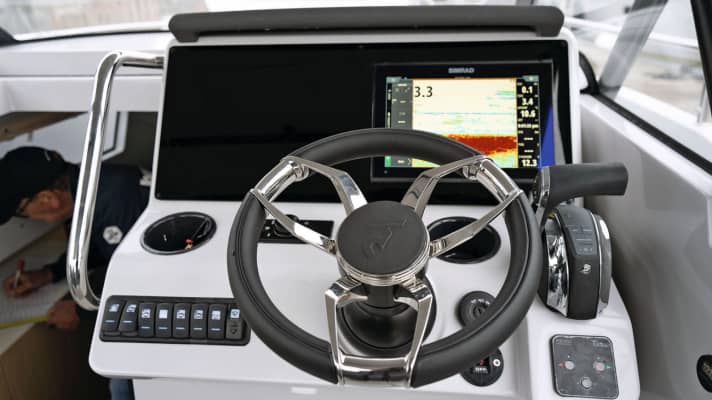
Even at first glance, the Ryck 280 shows its roots: a large cockpit, covered by a so-called T-top, a slightly inclined stern and a generous sunbathing area on the foredeck are instantly reminiscent of the large sister ships from the same company. We have a similar experience below deck. Here, too, you can still feel the compromises that the forefathers of the first Fjord models had to make in the design: if you want space and flat contours above, you have to tuck your head in below: With a maximum headroom of around 1.8 metres in the cabin, the Ryck is certainly no space miracle below deck. The same applies to the toilet room, which is equipped with an impressively large washbasin and, with a headroom of 1.65 metres, is even more cramped. On the other hand, the double bed in the cabin is impressive with a sleeping area of 2 m x 2 m and 10 cm thick cushions. Storage space can be found under the bunks and in the cupboards and drawers in the companionway. Light and air reach the cabin via two side windows, an escape hatch in the foredeck and the sliding door to the cockpit. The side walls are lined with upholstered fabric and the fittings are in light-coloured imitation wood. Both of these features enhance living comfort.
Cooking on the Ryck 280 takes place in the open cockpit. If you order the optional wet bar, you get a two-burner gas cooker and a sink with hot and cold water (22-litre boiler). A Dometic fridge drawer is easily accessible underneath the rear seating area.
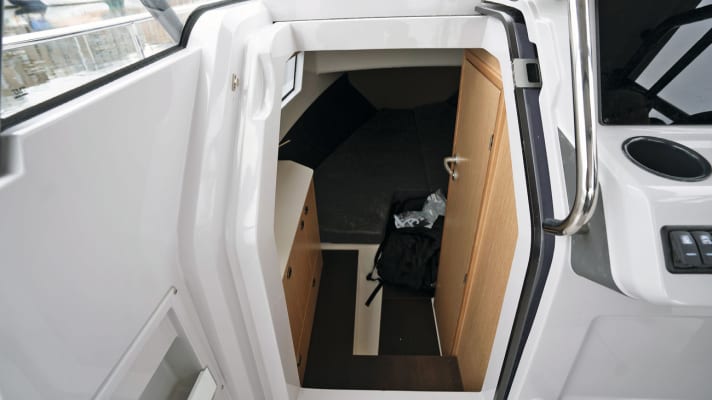
Back at the helm, the first thing that catches the eye is the instrumentation. The Simrad Go12 flat screen informs the skipper about navigation and technical data such as temperatures, pressures and fill levels. Operation is via touchscreens, which can be largely configured to the skipper's preferences, or the control unit.
To the left of the steering wheel is a switch panel that can be used to switch basic functions such as lights and pumps. The electric single-lever control for the Mercury Verado is mounted to the right of the easy-grip steering wheel. The layout of all the controls is good and functional.
The driver and co-driver sit in well-shaped and adjustable bucket seats with plenty of legroom. The lateral support is excellent, the only thing you would wish for is a footrest and additional support for the front passenger.
The windscreen, set in a solid aluminium frame, makes a stable impression, with only a few reflections and the comparatively small windscreen wiper area detracting from the good overall impression. Enough of the preliminaries. Let's get down to what this boat was built for: driving. If you bring the 250 hp of the Mercury V8 Verado to life, you have the choice between loud and quiet. In plain language: the engine touchscreen can be used to influence the exhaust routing and thus the noise level. A nice gimmick, but irrelevant for the test - we like it quiet and therefore leave the exhaust in the comfort setting.
Thanks to the bow thruster and outboard drive, harbour manoeuvres are child's play. When engaged forward, the turning circles (without bow thruster assistance) are between 1.5 and two boat lengths - that's good. In reverse, they are three boat lengths to either side - that's a bit much. You should stop reversing at 2700 rpm at the latest, otherwise water will run over the stern. At slow displacement speed between 1200 and 1500 rpm, which corresponds to a speed of 5 knots, weight shifts have no effect on course stability, the boat runs straight ahead and the tank capacity of 300 litres would be sufficient for 188 nm plus 15 percent reserve. If you rev the engine higher, you reach the fast displacement speed at around 1800 to 2000 rpm (7 kn to 8 kn), in which wave formation and the noise level (68 db) increase. At this point, a word of praise to the engine builders: both the objective noise level and the perceived "sound" of the Verado are in a class of their own. The engine sounds "rich" in all speed ranges without being intrusive. The maximum 82 db(A) we measured is a top value - chapeau!
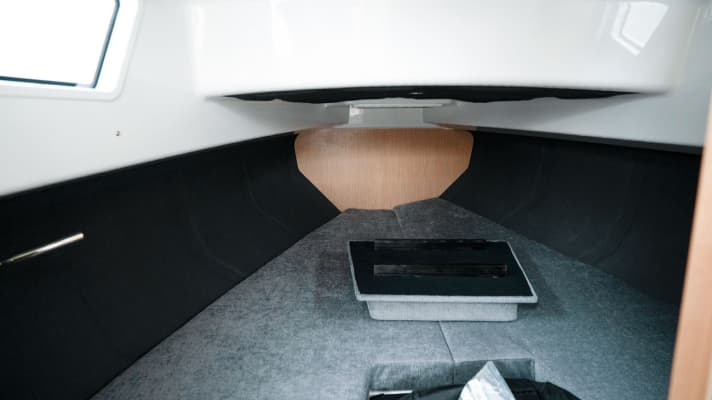
Back to the boat. We reach the harbour exit and accelerate the Ryck 280 up to the glide limit, which is between 3200 and 3800 rpm. At this speed, around 40 litres of super fuel per hour run through the pipes, which reduces the range to a meagre 80 nm.
We continue to accelerate and reach the good and therefore most economical planing speed at 4500 to 5000 rpm. The range increases again to 120 nm, the GPS shows 31 knots, and the sound from the stern is a moderate 80 dB(A). All good values. Everything that can now be extracted from the 4.6 litre displacement of the Verado in terms of speed reserves is used exclusively for driving pleasure and thus the main task of the Ryck 280. The last 1000 revolutions up to the maximum speed of 6000 rpm correspond to an increase in speed of a whopping 10 knots. When optimally trimmed, the Ryck literally flies over the water at 40 kn, which is due not least to her double-stepped hull. It creates an air cushion between the hull and the water surface, which effectively minimises water resistance. But there is also another effect of this air cushion: if you force the 9-metre boat into extreme turns with this setup (trim) and at top speed, this leads to a powerslide that ends in a 360-degree turn. According to the test report: "Spectacular, but not dangerous". There is really nothing more to add to this statement. The Ryck remains good-natured in all riding situations and is always controllable, even by less experienced riders. On the downside: in tight bends, the boat leans noticeably onto its side, so that the roof comes into the driver's field of vision and takes away the side view. The comparatively calm Greifswalder Bodden on the test day (2 to 3 Beaufort, sea state 0) does not allow an objective assessment of the rough water qualities. Just this much: the Ryck passed through the stern waves of other boats without any recognisable defects. Back in the harbour, we turned our attention to safety. After the boat scored points at sea with its excellent, and therefore safe, handling characteristics, our expectations were high: non-slip anti-slip structures on deck, stable railings, handrails, cleats and rubbing strakes, a well-dimensioned electrically operated anchor gear, an outboard self-draining cockpit and three bilge pumps (2 electric, 1 manual) emphasise the initially good impression. However, we were less impressed by the lack of a fuel shut-off valve, the lack of a water separator, the absence of a fire extinguisher, the non-BSH-approved navigation lights and the optional towing eyes on the bow and stern. Small stuff? Sure, but small stuff of relevance. The same applies to parts of the electrical system: the outdated fuses are located behind one of the built-in cupboards on the companionway to port and can only be reached in an emergency after the cupboard has been cleared out. They are also inadequately labelled and can only be clearly identified using the logbook. And the main battery switch, located under a flap in the cockpit floor, could also be placed in a more accessible position. Enough criticism. Let's move on to the conclusion. Does the Ryck 280 have the potential to build on the success of its big sister ship, the Fjord? The answer is yes. Despite the lack of detail, which is also due to the fact that the test boat is construction number 4, the boat fulfils all the requirements of a modern day cruiser and sets standards in this class, not least with its handling characteristics.
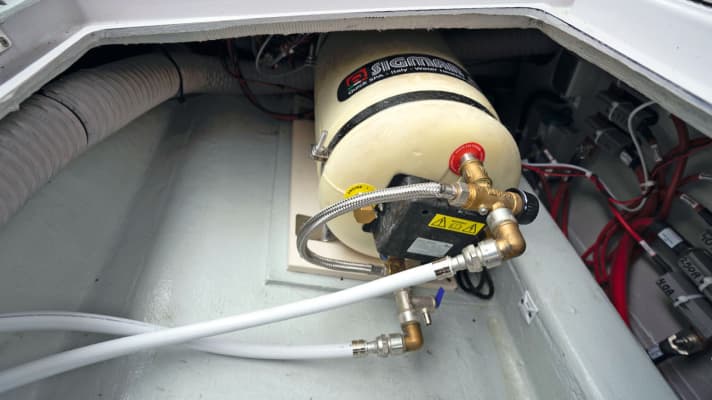
Conclusion
The Ryck 280 is fun. It is not only visually appealing, but also impresses with its fast and safe handling characteristics in all situations. With 250 hp
at the stern, the boat is more than sufficiently motorised. The living space is limited due to the concept and the standard equipment fulfils minimum requirements. Due to the early build number (4), there are a few flaws in the workmanship, which the shipyard intends to rectify. Anyone looking for a fast day cruiser should take a look at the Ryck 280.
Need more information? You can find the test of the Ryck 280 with further pictures, measurement results and full evaluation in BOOTE issue 01/2022 from 15.12.2021 at newsstands or online at Delius Klasing Shop.

